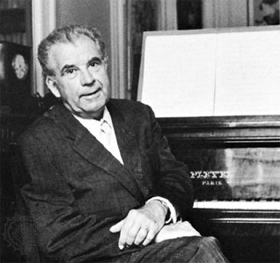Trivia
Famous trumpet works - Concertos, part 2
Jumping forward more than a century from the concerto introduced in the previous section brings us to two concertos that were composed in the twentieth century. With the invention of the valve trumpet, the expressive power of the instrument improved dramatically. As a result, the trumpet assumed an important role as a melodic instrument-even in orchestral works. Contrary to this, however, the romantic composers of the nineteenth-century hardly ever employed the trumpet as a solo instrument in their works, and it was not until the twentieth century that composers focused on the trumpet as a solo instrument.
A. Jolivet: Trumpet concertos
The French composer André Jolivet has left behind two trumpet concertos. The title of the First Trumpet Concerto was changed to Concerto for Trumpet, Strings, and Piano. The work was composed for the Paris Conservatoire concours. It was originally written for trumpet and piano; however, a string part was subsequently added. The theme of the trumpet interacting with the metallic tones of the piano and strings apparently caused something of a scandal when the work was first performed.
The second concerto, which makes use of jazz idioms, consists of three movements and is brimming with the occultism and primeval energy which Jolivet was continually seeking. The backing orchestration is highly unorthodox, with an ensemble in which the wind instruments and percussion predominate.

André Jolivet (1905-1974)
H. Tomasi: Trumpet Concerto
Born in Marseille of Corsican descent, Henri Tomasi established a reputation as a composer of stage productions and left behind many famous works for wind instruments. Regarded as masterpieces that represent the outstanding trumpet concertos of the twentieth century, this concerto and the concertos composed by Jolivet have been taken on by many trumpeters.
The work consists of three movements, with the motifs redolent of a movie score and the orchestration serving to showcase the trumpet solos.
Musical Instrument Guide:Trumpet Contents
Structure
How the Instrument is Made
Choosing an Instrument
Care and Maintenance
Trivia
- Trumpeters in Bach's time alternated between instruments with a variety of ranges when performing
- The keyed trumpet-the fruit of the evolutionary process
- Famous trumpet works - Concertos, part 1
- Famous trumpet works - Concertos, part 2
- Famous trumpet works - Solos
- Is a Flugelhorn a horn? Or a trumpet?
- The highest note a trumpet can produce
- Aida trumpets for the "Grand March"
- The secret of the trumpet's traditional tone: small impurities!?
